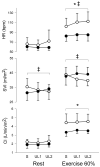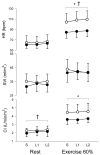Effect of changes in intrathoracic pressure on cardiac function at rest and during moderate exercise in health and heart failure
- PMID: 22080485
- PMCID: PMC3272085
- DOI: 10.1113/expphysiol.2011.061945
Effect of changes in intrathoracic pressure on cardiac function at rest and during moderate exercise in health and heart failure
Abstract
This study investigated the effect of changes in inspiratory intrathoracic pressure on stroke volume at rest and during moderate exercise in patients with heart failure and reduced ejection fraction (HFREF) as well as healthy individuals. Stroke volume was obtained by echocardiography during 2 min of spontaneous breathing (S), two progressive levels of inspiratory unloading (UL1 and UL2) using a ventilator, and two progressive levels of inspiratory loading using resistors in 11 patients with HFREF (61 ± 9 years old; ejection fraction 32 ± 4%; NYHA class I-II) and 11 age-matched healthy individuals at rest and during exercise at 60% of maximal aerobic capacity on a semi-recumbent cycle ergometer. At rest, inspiratory unloading progressively decreased stroke volume index (SVI; S, 35.2 ± 5.4 ml m(-2); UL1, 33.3 ± 5.1 ml m(-2); and UL2, 32.2 ± 4.4 ml m(-2)) in healthy individuals, while it increased SVI (S, 31.4 ± 4.6 ml m(-2); UL1, 32.0 ± 5.9 ml m(-2); and UL2, 34.0 ± 7.2 ml m(-2)) in patients with HFREF (P = 0.04). During moderate exercise, inspiratory unloading decreased SVI in a similar manner (S, 43.9 ± 7.1 ml m(-2); UL1, 40.7 ± 4.7 ml m(-2); and UL2, 39.9 ± 3.7 ml m(-1)) in healthy individuals, while it increased SVI (S, 40.8 ± 6.5 ml m(-2); UL1, 42.8 ± 6.9 ml m(-2); and UL2, 44.1 ± 4. ml m(-2)) in patients with HFREF (P = 0.02). Inspiratory loading did not significantly change SVI at rest or during moderate exercise in both groups. It is concluded that inspiratory unloading improved SVI at rest and during moderate exercise in patients with HFREF, possibly due to a reduction in left ventricular afterload.
Figures


References
-
- Atherton JJ, Moore TD, Lele SS, Thomson HL, Galbraith AJ, Belenkie I, Tyberg JV, Frenneaux MP. Diastolic ventricular interaction in chronic heart failure. Lancet. 1997;349:1720–1724. - PubMed
-
- Borg G. Perceived exertion as an indicator of somatic stress. Scand J Rehabil Med. 1970;2:92–98. - PubMed
-
- Bradley TD, Holloway RM, McLaughlin PR, Ross BL, Walters J, Liu PP. Cardiac output response to continuous positive airway pressure in congestive heart failure. Am Rev Respir Dis. 1992;145:377–382. - PubMed
-
- Brecher GA, Hubay CA. Pulmonary blood flow and venous return during spontaneous respiration. Circ Res. 1955;3:210–214. - PubMed
Publication types
MeSH terms
Grants and funding
LinkOut - more resources
Full Text Sources
Other Literature Sources
Medical

